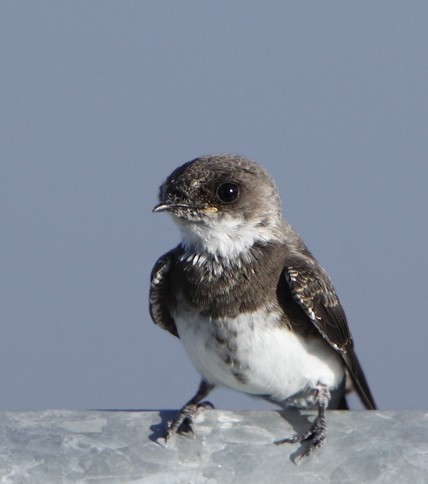Bank Swallow
A species of Riparia, Also known as Northern Sand-martin, Common Sand-martin Scientific name : Riparia riparia Genus : Riparia
Bank Swallow, A species of Riparia
Also known as:
Northern Sand-martin, Common Sand-martin
Botanical name: Riparia riparia
Genus: Riparia
Content
Description People often ask General Info
Description
The sand martin is brown above, white below with a narrow brown band on the breast; the bill is black, the legs brown. The young have rufous tips to the coverts and margins to the secondaries. Its brown back, white throat, small size and quick jerky flight separate it at once from similar swallows, such as the common house martin (Delichon urbicum), the American cliff swallow (Petrochelidon pyrrhonota) or other species of Riparia. Only the banded martin (R. cincta) of sub-Saharan Africa is similar, but the sand martin only occurs there in (the northern) winter. Measurements: Length: 4.7-5.5 in (12-14 cm) Weight: 0.4-0.7 oz (10.2-18.8 g) Wingspan: 9.8-13.0 in (25-33 cm) The sand martin's twittering song is continuous when the birds are on the wing and becomes a conversational undertone after they have settled in the roost. The harsh alarm is heard when a passing falcon, crow or other suspected predator requires combined action to drive it away. 
Size
12 cm
Colors
Brown
Gray
White
Life Expectancy
8 years
Nest Placement
Burrow
Clutch Size
3 - 5 eggs
Incubation Period
1 - 2 broods
Number of Broods
13 - 15 days
Nestling Period
18 - 21 days
Feeding Habits
Bank Swallow predominantly prey on aerial insects like bees, wasps, ants, butterflies, and moths, capturing their food mid-flight, sometimes up to 50 feet high. Rarely, they also pick insects from the ground or water surfaces. Bank Swallow feed both individually and in flocks.
Habitat
Bank Swallow are commonly observed in open habitats near water bodies such as rivers, streams, lakes, and ocean coasts. These birds show a preference for areas with available vertical dirt or sandbanks for nesting, often in low elevation zones. Typically, they inhabit regions with minimal tree cover, opting for open fields, marshes, and man-made environments like gravel pits or roadside embankments. While historically favoring natural bluffs, their adaptability has led to the use of quarried areas for colonial nesting sites.
Nest Behavior
Males begin burrowing before mating. Females assist in forming the nest where they lay eggs. Nest building occurs without specific timing patterns, and both parents care for the young in the constant temperature of the nest chamber.
Nest Characteristics
Bank Swallow's nests are located in large colonies within vertical banks near water bodies, typically in the upper third of the bank. Burrows, about 25 inches deep, lead to a nest chamber lined with a mat of straw, grasses, leaves, or rootlets, around 1 inch thick and 5 inches in diameter.
Dite type
Insectivorous
People often ask
General Info
Feeding Habits
Bird food type
Bird Feeder Type

Platform
Sounds
Call
Recording location: Belgium
Call
Recording location: Belgium
Behavior
Bank Swallow showcases a life full of aerial agility, expertly catching insects mid-flight with rapid, fluttery wingbeats and occasionally interspersing these with smooth glides. Unlike their relatives, their flight pattern is less convoluted, opting for straighter trajectories. Social by nature, bank Swallow is rarely found in isolation, preferring the company of its kin or mingling with other swallows, particularly during migratory periods. In colder temperatures, they seek warmth in groups. During breeding season, males exhibit an industrious side, diligently excavating burrows as a prelude to courtship and singing to entice females. Despite fiercely guarding their chosen burrow territory, if a male's efforts fail to attract a partner, he readily abandons the site. Monogamy is seasonal, and within their densely populated colonies, mating outside the primary pair is not uncommon.
Species Status
Not globally threatened.
Scientific Classification
Phylum
Chordates Class
Birds Order
Perching birds Family
Swallows Genus
Riparia Species
Bank Swallow 